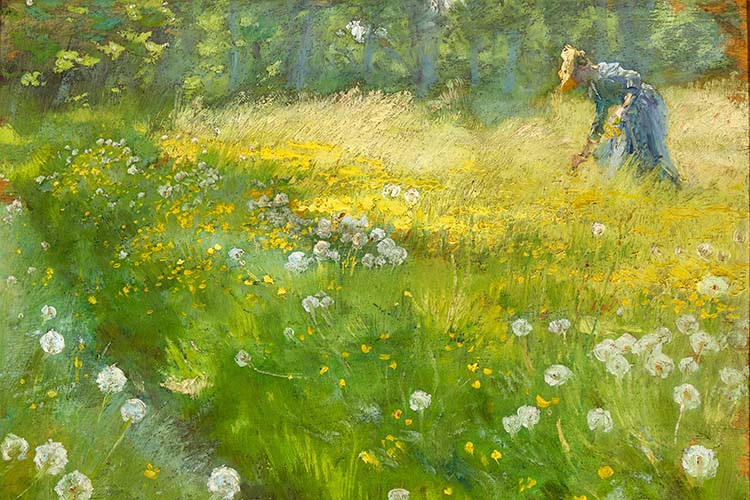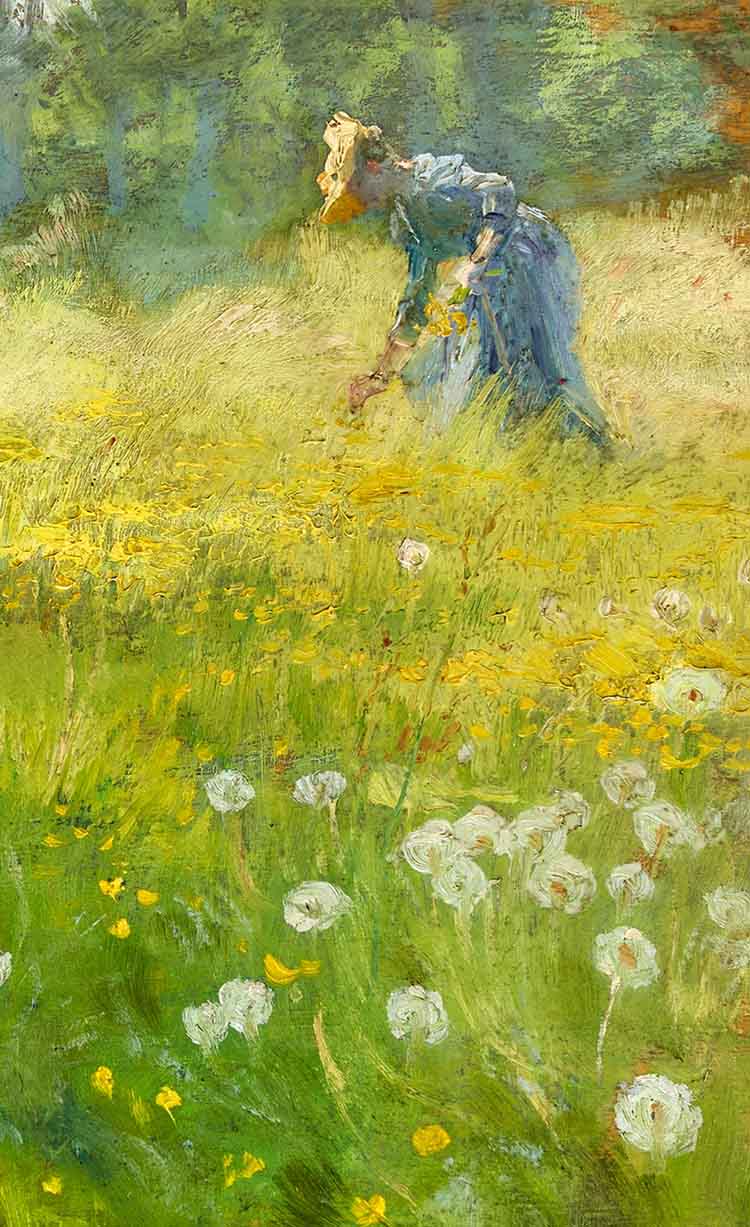Impressionist masterpiece by Peder Severin Krøyer
Peder Severin Krøyer held a deep fascination for natural light and plein-air painting. His talent for capturing fleeting moments in nature – from the serene blue hour by the sea to the radiant light of a sunny day – has earned him his place as one of Denmark’s most celebrated artists. As a special highlight, the impressionist masterpiece by the Skagen painter is now set to go under the hammer at the Live Auction with an estimate of DKK 4–6 million.
The work in question is “Fru Marie Krøyer i Haven paa Skagen” (Marie Krøyer in the garden in Skagen) from June 1892 – a portrait of his wife Marie amid the radiance of a sun-drenched summer garden. It emerges from one of Peder Severin Krøyer’s most blissful summers in Skagen, and everything in the painting revolves around nature, light and colour. Standing out in the garden with his canvas and easel, Peder Severin Krøyer captured in small, vibrating brushstrokes this moment when Marie bends down to pick a flower. It is an unusually liberated, modern work, where every element of the composition radiates vitality, light and colour. Previously owned by Marie Krøyer’s brother Waldemar Triepcke, the work later became part of the Norwegian businessman Petter Olsen’s art collection.
“Peder Severin Krøyer – or Søren as he was known – and Marie Krøyer had a complicated relationship, marked by periods of profound joy and deep despair due to Peder Severin Krøyer’s struggles with manic-depressive illness. The work up for auction represents a very happy time in their life together, when their love and art flourished.”
Julie Arendse VossSpecialist & head of department of fine art at Bruun Rasmussen
Peder Severin Krøyer's impressionism
Peder Severin Krøyer is often referred to as an impressionist painter, and his plein-air painting was profoundly influenced by the French art scene. From 1877–79, he studied under the French artist Léon Bonnat, but in Paris, he also moved within the same artistic circles as the masters of French Impressionism. He exhibited alongside Claude Monet at the prestigious exhibition “Exposition Internationale de Peinture” in “Galerie Georges Petit” in 1884 and later together with Pierre-Auguste Renoir, Camille Pissarro, Berthe Morisot and the British artist Alfred Sisley.
Peder Severin Krøyer’s training at the Royal Danish Academy of Fine Arts in Copenhagen was rooted in naturalism, and he largely remained faithful to this more traditional visual approach and associated technique. It is therefore also something of a rarity for us to be able to present this fully-fledged impressionist masterpiece at auction on 2 December. It is without doubt one of Peder Severin Krøyer’s most accomplished impressionist paintings.
|
|
Happy years in Skagen
Peder Severin Krøyer and Marie Triepcke were married in 1889. Not only was Marie an artist in her own right, but she also became Krøyer’s muse and favourite model. Following an extended Italian honeymoon, the Krøyers returned to Denmark in 1891, renting Madam Bendsen’s house in Skagen that summer and the next two summers. The summer of 1892 also gave rise to one of Peder Severin Krøyer’s most iconic works, “Sommeraften ved Skagen” (Summer evening in Skagen), depicting Marie at the water’s edge in a long, white summer dress, accompanied by their dog Rap in the very special evening atmosphere – ‘the blue hour’ – which was so characteristic of Peder Severin Krøyer’s art from the period.

|
Madam Bendsen’s garden
The painting thus stands as an artistic testimony to Peder Severin Krøyer’s happy years in Skagen. It is part of a small series of garden motifs from Madam Bendsen’s house with Marie as a model, of which “Roser” (Roses) from 1893 is one of the most famous. However, the work up for auction, “Fru Marie Krøyer i Haven paa Skagen”, differs from the other garden pictures in several ways.
“In the other garden pictures from the period, the model is very obviously Marie Krøyer. But in this painting, she is more a painterly figure, where the contours are blurred and replaced by flowing transitions of colour and light. Her presence serves a compositional purpose, bringing vitality, variation and contrasting colours to the scene. Were it not for the title identifying the figure as Marie, we would not know that it is her for sure. In this work, Marie transcends individual identity to become something more ethereal – an indefinable beauty.”
Julie Arendse VossSpecialist & head of department of fine art at Bruun Rasmussen

For further information, please contact
|
|
Julie Arendse VossJulie Arendse VossHead of department / 19th Century & Old Master Paintings / København |


